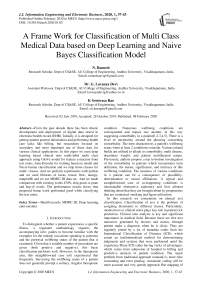A Frame Work for Classification of Multi Class Medical Data based on Deep Learning and Naive Bayes Classification Model
Автор: N. Ramesh, G. Lavanya Devi, K. Srinivasa Rao
Журнал: International Journal of Information Engineering and Electronic Business @ijieeb
Статья в выпуске: 1 vol.12, 2020 года.
Бесплатный доступ
From the past decade there has been drastic development and deployment of digital data stored in electronic health record (EHR). Initially, it is designed for getting patient general information and performing health care tasks like billing, but researchers focused on secondary and most important use of these data for various clinical applications. In this paper we used deep learning based clinical note multi-label multi class approach using GloVe model for feature extraction from text notes, Auto-Encoder for training based on model and Navie basian classification and we map those classes for multi- classes. And we perform experiments with python and we used libraries of keras, tensor flow, numpy, matplotlib and we use MIMIC-III data set. And we made comparison with existing works CNN, skip-gram, n-gram and bag-of words. The performance results shows that proposed frame work performed good while classifying the text notes.
Health records, MIMIC-III, Deep learning, auto-encoder
Короткий адрес: https://sciup.org/15017079
IDR: 15017079 | DOI: 10.5815/ijieeb.2020.01.05
Список литературы A Frame Work for Classification of Multi Class Medical Data based on Deep Learning and Naive Bayes Classification Model
- Hai, J., et al. (2019). "Multi-level features combined end-to-end learning for automated pathological grading of breast cancer on digital mammograms." Computerized Medical Imaging and Graphics 71: 58-66.
- Kocbek S, Cavedon L, Martinez D, Bain C, Mac Manus C, Haffari G, et al. Text mining electronic hospital records to automatically classify admissions against disease: measuring the impact of linking data sources. J Biomed Inform. 2016; 64:158–67.
- Yetisgen-Yildiz M, Pratt W. The effect of feature representation on Medline document classification. AMIA Annu Symp Proc. 2005;2005:849–53.
- Setio AAA, Ciompi F, Litjens G, Gerke P, Jacobs C, et al. 2016. Pulmonary nodule detection in CT images: false positive reduction using multi-view convolutional networks. IEEE Trans. Med. Imaging 35:1160–69.
- Beaulieu-Jones, B.K., Greene, C.S., et al.: Semi-supervised learning of the electronic health record for phenotype strati cation. Journal of biomedical informatics 64, 168 -178 (2016).
- Ferr´andez O, South BR, Shen S, Meystre SM (2012) A hybrid stepwise approach for de- identifying person names in clinical documents. In: Proceedings of the 2012 Workshop on Biomedical Natural Language Processing, Association for Computational Linguistics, pp 65–72.
- Lin YK, Chen H, Brown RA , MedTime: A temporal information extraction system for clinical narratives. Journal of biomedical informatics 46:S20–S28 (2013).
- T. Tran, T. D. Nguyen, D. Phung, and S. Venkatesh, “Learning vector representation of medical objects via EMR-driven nonnegative restricted Boltzmann machines (eNRBM),” Journal of Biomedical Informatics, vol. 54, pp. 96–105, 2015.
- R. Miotto, L. Li, B. A. Kidd, and J. T. Dudley, “Deep Patient: An Unsupervised Representation to Predict the Future of Patients from the Electronic Health Records.” Scientific reports, vol. 6, no. April, p. 26094, 2016.
- Z. Che, D. Kale, W. Li, M. Taha Bahadori, and Y. Liu, “Deep Computational Phenotyping,” in Proceedings of the 21st ACM SIGKDD International Conference on Knowledge Discovery and Data Mining, 2015, pp. 507–516.
- J. C. Denny, T. A. Lasko, and M. A. Levy, “Computational Phenotype Discovery Using Unsupervised Feature Learning over Noisy, Sparse, and Irregular Clinical Data,” PLoS ONE, vol. 8, no. 6, 2013.
- C. Angermueller, T. P¨arnamaa, L. Parts, and O. Stegle, “Deep learning for computational biology,” Molecular systems biology, vol. 12, no. 7, p. 878, 2016.
- Franck Dernoncourt, Ji Young Lee, Peter Szolovits, “De-identification of Patient Notes with Recurrent Neural Networks,” arXiv:1606.03475v1 [cs.CL] 10 Jun 2016.
- A. E. Shweta, S. Saha, and P. Bhattacharyya, “Deep learning architecture for patient data de-identification in clinical records,” ClinicalNLP 2016, p. 32, 2016.
- E. Choi, M. T. Bahadori, and J. Sun, “Doctor AI: Predicting Clinical Events via Recurrent Neural Networks,” arXiv, pp. 1–12, 2015.
- E. Choi, M. T. Bahadori, E. Searles, C. Coffey, and J. Sun, “Multi-layer Representation Learning for Medical Concepts,” arXiv, pp. 1–20, 2016.
- Pennington, Richard Socher, Christopher D. Manning " GloVe: Global Vectors for Word Representation" Proceedings of the 2014 Conference on Empirical Methods in Natural Language Processing (EMNLP), pages 1532–1543 (2014).
- http://dx.doi.org/10.13026/C2XW26


